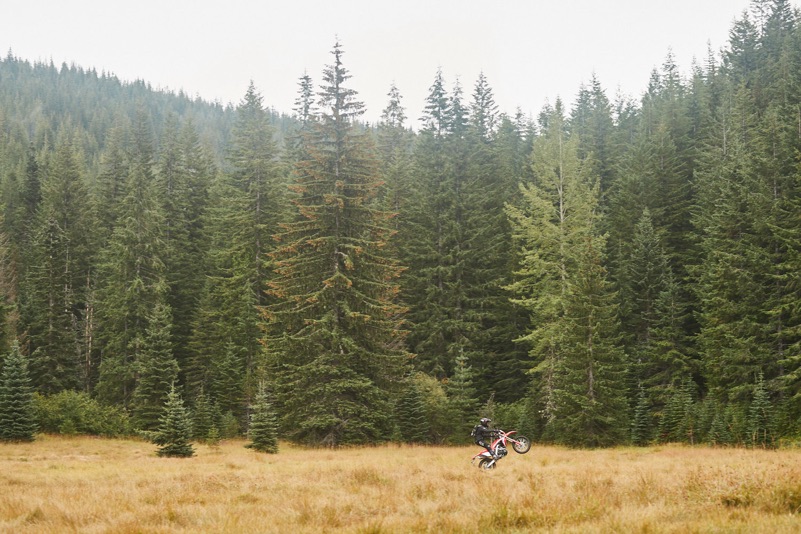Share This Article
Story Written By Michael Allen
For years now most people in the motorcycling world, including myself have been asking the same question; why have no Japanese manufacturers fed the starving masses what they’re hungry for, a real dual sport machine? Well comes to find out at the end of this long wait these reasons ended being the reason the 2019 CRF450L is so damn good. It all starts with culture… European and Japanese manufacturers have very different philosophies on business and how motorcycles are to be made. When the market took a downturn in 2008, KTM saw a chance to jump on a dual sport market that was lacking and they did a great job providing the public with great dirt bikes with license plates. The Japanese are much more conservative in business and in turn somewhat let the dual sport market be ruled by the Euros for the next 10 years. Fast forward to late 2018 and we have come to find out that for the last few years Honda has been developing an entirely new model (along with 6 others). You see, Honda didn’t want to just take an old carbureted 450X and add a license plate because that would just be a dirt bike instead of a true dual sport. That being said Honda did use the all new 450X as a platform for the 450L, but also added a lot of things that make the new model work well on AND off road.
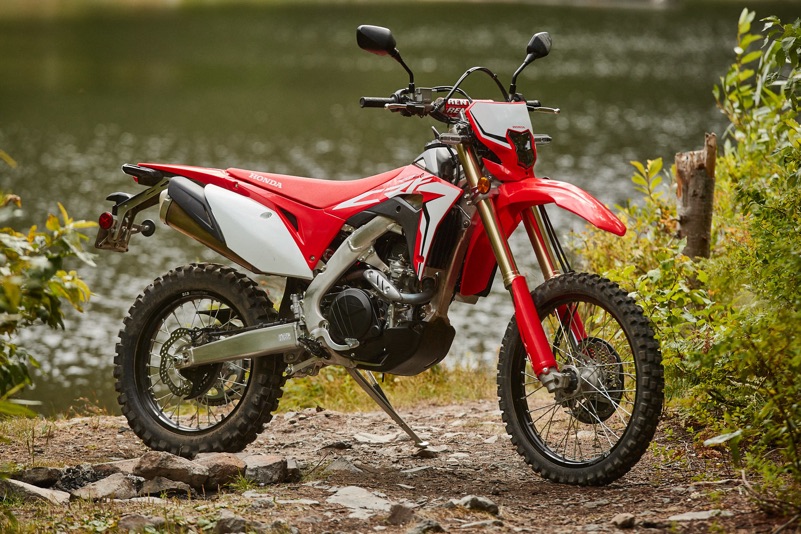
Honda released seven new models this June and the two that are closely related are the 450X and the 450L. While they are both roughly based off the CRF450R and CRF450RX there are many differences. The basic engine configuration is the same, but the internals are very different. In the 450L engine, the compression ratio has been decreased to 12:1, valve timing is specific to the L, the crank inertia is 12% greater than the 450R, which acts like a flywheel weight and helps with tractability on the trail. There is a new piston with three rings, a new six speed transmission, lighter clutch pull, larger radiators, an electric fan, dedicated ECU settings and a DOT specific exhaust system. With these different internals the engine gained 5.1 pounds over the CRF450R. On the chassis and suspension side, the “L” also shares a lot of slightly modified “R” parts. The frame although based off of the “R” is slightly wider between the foot pegs, the head tube has slightly more rake and the sub frame on the L extends almost all the way to the end of the rear fender to help support the weight of the tail light and license plate. The shock and 49mm forks are the same ones that come on the 450R, but have internal changes in valving, spring rate, and have fork lugs with slightly more off-set. The front brake on the L has a larger reservoir and a thicker disk to meet DOT requirements. In the drivetrain Honda did some cool things to help keep road noise down. The chain is fully sealed, on the rear sprocket there is a rubber ring around the outer edge that the chain rides on and slightly compresses. What this does is eliminate lashing noise on the rear sprocket. In addition to the rear sprocket is a chain guard that fully covers the front sprocket and keeps the noise isolated.
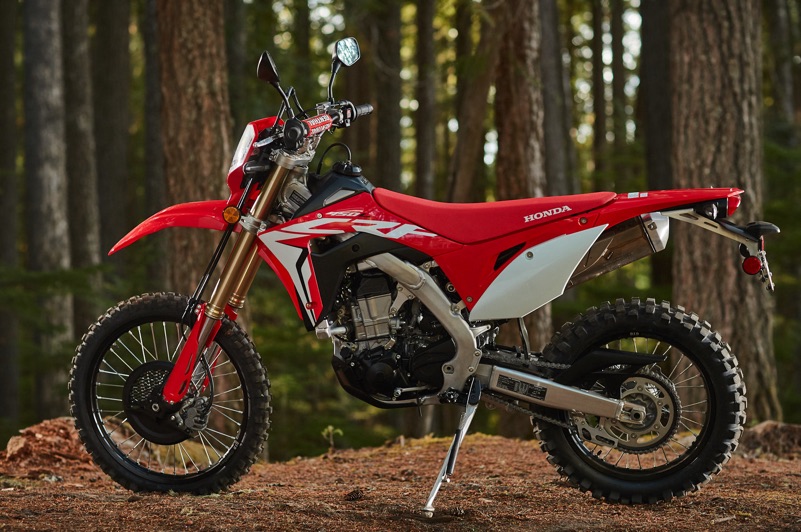
Also to keep things isolated, the swing arm is filled with polyurethane to keep vibration to a minimum (this also gives the rear suspension a bit more of a dead feeling when on the trails). The engine side cases on both sides have plastic covers that are isolated by foam and help greatly reduce engine noise and vibration as well as having a substantial factory plastic skid plate. The titanium fuel tank holds two gallons and the digital readout will give the rider live MPG as well as tell you how much fuel has been used (the bike averaged about 47 MPG). The L comes with very street-ish IRC dual sport tires (although for this event the bikes had Dunlop 606’s) wrapped on black DID rims. One area where I think Honda really took the dual sport game to the next level is the license plate, turn signals, and lights. The License plate bracket is mounted directly to the sub frame and is spaced far enough back that even after 102 miles of hard riding (including jumps with hard landings) the tire never touched it and it never bent. Everyone knows that dual sport turn signals are always a weak point, so Honda went back to the drawing board and created all new LED signals that can be bent in any direction without breaking, getting permanently damaged and just flex back to their original position. All the lights on the new 450L are LED and plenty bright with switches on the bars that are somewhat compact and simple to use. Finishing off the dual sport amenities are the mirrors, which in my opinion are just typical motorcycle mirrors that are fixed in their position. When leaning forward while riding I noticed the mirrors tended to hit me in the chest, breaking the jam nut loose and swiveled around on their own. Something I think this bike (as well as all off road bikes) could benefit from are factory handguards. This is a big pet peeve of mine because no one likes having their hands slapped by branches or being frozen by the cold weather.
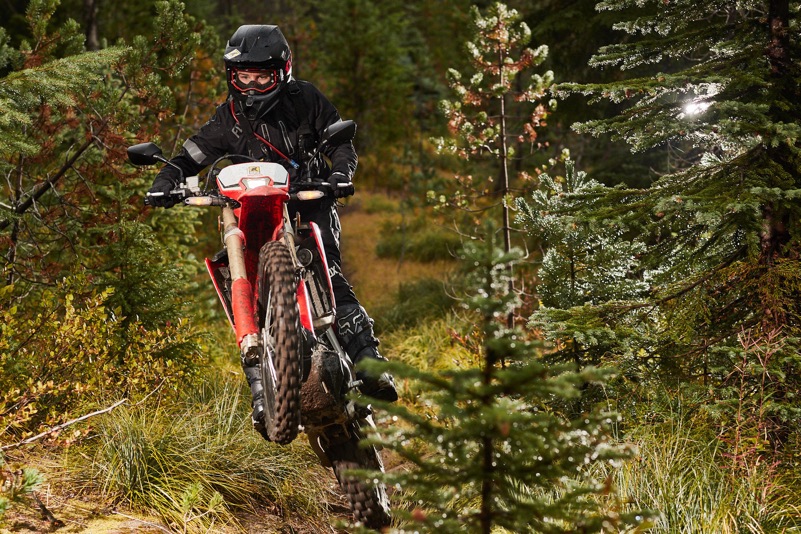
Now that all the technical info and new features are out of the way here’s how it does on and off-road: Before I fully get into it, I want to squash one thing right off the bat. I’ve seen a lot of comments on social media during the launch and it drives me nuts. People commenting everything from “man that’s just a 250L with a bigger engine,” to “looks like a piece of shit street bike,” and my favorite “all the reviews say it’s terrible” even though all reviews are embargoed until 9/17. So the first thing I want to say is that everyone needs to chill down, give this bike a chance and don’t hate on it before the reviews are even out, or better yet try and get a chance to ride one for yourself if you don’t take our word for it. Our ride started early in the morning in the Pacific Northwest with some wet asphalt roads that led onto some dirt. The first thing I noticed about the 450L was how quiet the exhaust was. Yes it sounds very muffled because there is a catalytic converter in the muffler. One thing we were told about the 450L is that Honda met every law and then some when it came to DOT regulations. The ECU cannot be modified and if the muffler is changed the bike will run too lean (it’s already pretty lean in stock form to meet regulations). With all that being said I’m sure someone in the aftermarket game will figure out a way to open this bike up to its true potential (albeit illegal). Another downside to the stock muffler is that since it has a cat (not meow) inside it, it has a tendency to get VERY hot. When I say very hot I mean glove and gear melting hot (don’t ask me how I know this). All the actions that Honda took to make the bike a pleasure to ride on the street really paid off. I’ve ridden other dual sports that vibrate your brains out while riding down the highway, but the 450L feels much more street like.
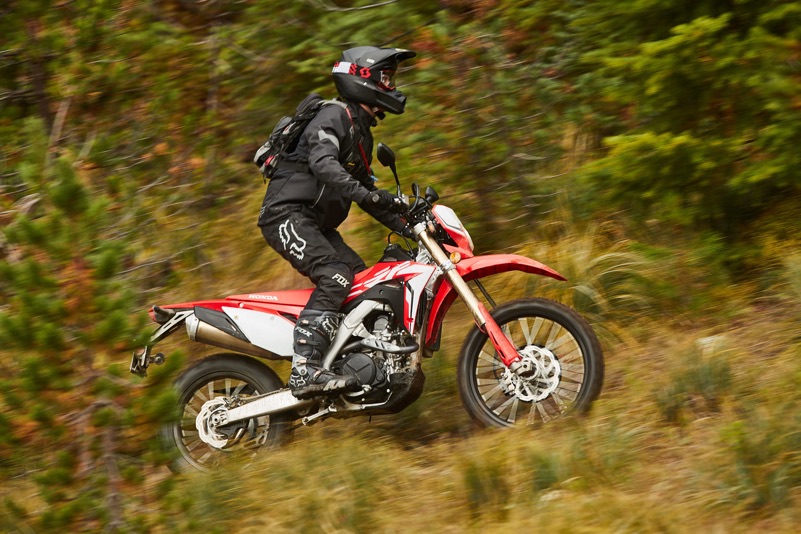
Once we got onto the first dirt/gravel road it was clear that the ergonomics were purely derived from the L’s dirt heritage. The Dunlop 606’s are about as good as you’re going to get when it comes to a good dirt/street mix tire, but it was still clear that there weren’t true knobby tires mounted up. The tires seem to grip for a good bit of the initial lean, but once they broke loose then started to slide it seemed like traction was nowhere to be found and the bike just kept drifting. Exiting corners the roll on power was very strong and seemed to build somewhat like a diesel. Off the bottom the power is very smooth and linear and I feel like once the extra mass of the crank and clutch get moving the power gets exciting but not in a violent way. When the mass gets spinning the engine really starts to pull with an amazing connection to the ground. There is little to no wheel spin, the power just gets put to the ground and accelerates instead of breaking loose and spinning the rear tire. However, there isn’t much point in revving the L out because all you’ll be doing is making noise (this bike likes to be short shifted).
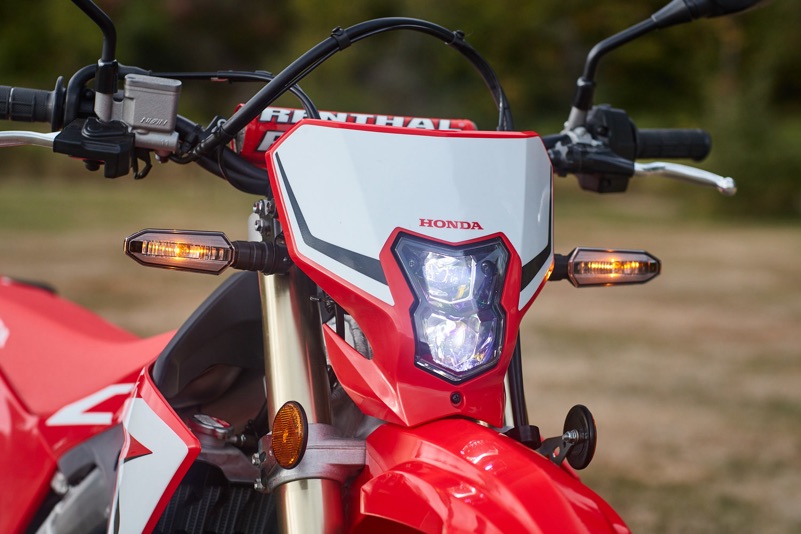
The dirt roads we were on had a lot of stutter bumps (washboards) and the L seemed to give minimal feedback in the seat and was very comfortable. One area of the suspension that gave me a little grief was on small square edged bumps, the forks had a slightly sharp feeling transferred to the bars. This was remedied by opening up the fork rebound two clicks. Riding the first bit of single track trail is when I realized that Honda had created a real competitive dual sport machine; one that the Europeans should take note of. Although the 450L weighs in at 289 pounds full of fuel (22 pounds heavier than its competition), on the trail you can hardly tell that it’s a bit on the heavy side. Moving down the trail, the L changes direction easily with minimal input and I found that it steers better standing up and weighting the pegs to change direction. The only time I really felt the extra weight was on tight switchbacks where the whole bike had to change direction from left to right (or vice versa) near 180 degrees. In that type of situation the slightly top heavy feeling started to show itself.
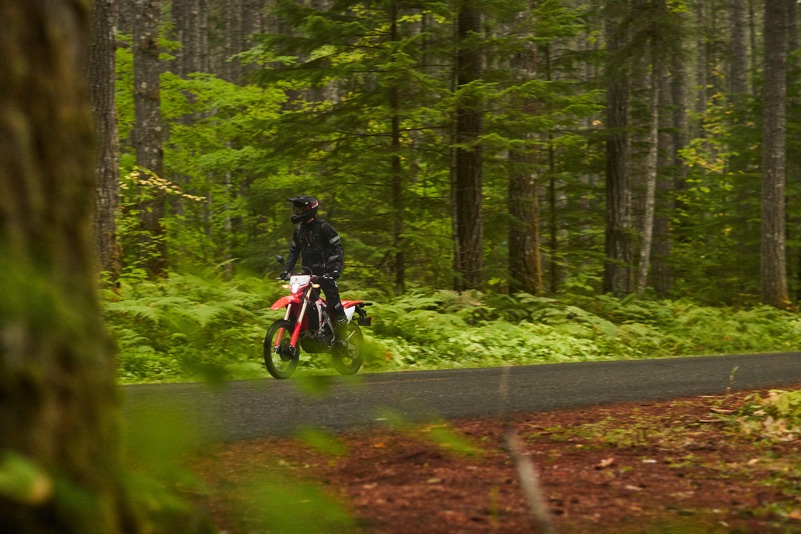
On faster flowing trails the suspension is clearly much more performance based than the European bikes, which feel very spongy and springy. The 450L has a much more performance based feeling and is able to be pushed at an aggressive pace. I only bottomed the bike once throughout the whole test day, and that was when a few other testers pointed out a road gap that they assured me I could jump (they were right, I could jump it, but the landing was less than ideal). I think Honda did a great job blending comfort with performance with this bike and I’m sure most of the consumers will agree.
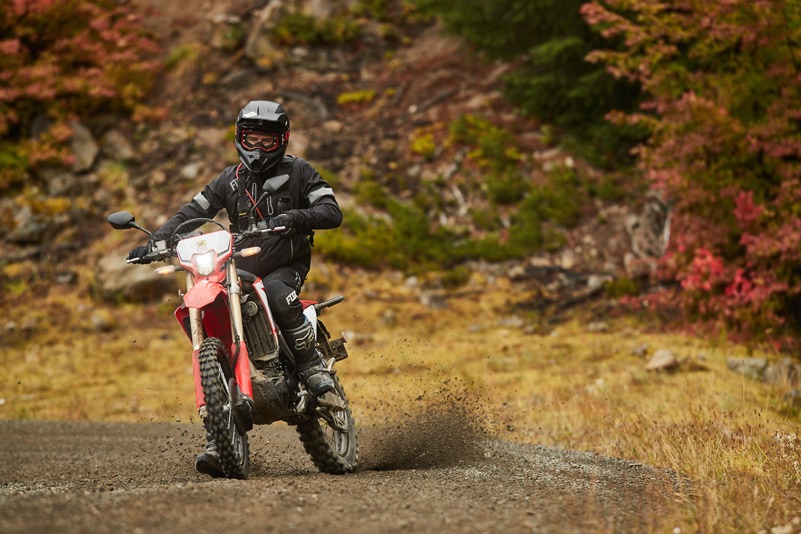
Having a six speed transmission is a great addition to the new L for a couple reasons. Having a low first gear gives you the ability to tackle slower more technical terrain, and having a tall sixth gear gives you the ability to cruise down the highway at 65mph without feeling like you’re wringing the bikes neck. Speaking of sixth gear, the L has a governor set at 91mph (I know because I found it). When you hit 91mph the Honda feels like it’s still pulling, but then feels like someone hit the kill switch and it drops about 5mph before it starts to pull again. On multiple occasions I found a false neutral between fourth and fifth gear when I was being lazy and not fully moving my toe all the way up when shifting. Another slightly annoying trait was that the bike had a tendency to flame out if I wasn’t covering the clutch in technical terrain. This was slightly remedied by turning up the idle, but still happened from time to time. When this would happen, having electric start was nice, but having a clutch cancel switch wasn’t. When the bike stalls the clutch needs to be pulled in to be re-started, which is ok, but for the switch to be engaged the lever needs to be pulled in all the way to the bars. This means you can’t just two finger the clutch and fire the bike (because the other two fingers block the lever, this just takes an extra second and is a nuisance).
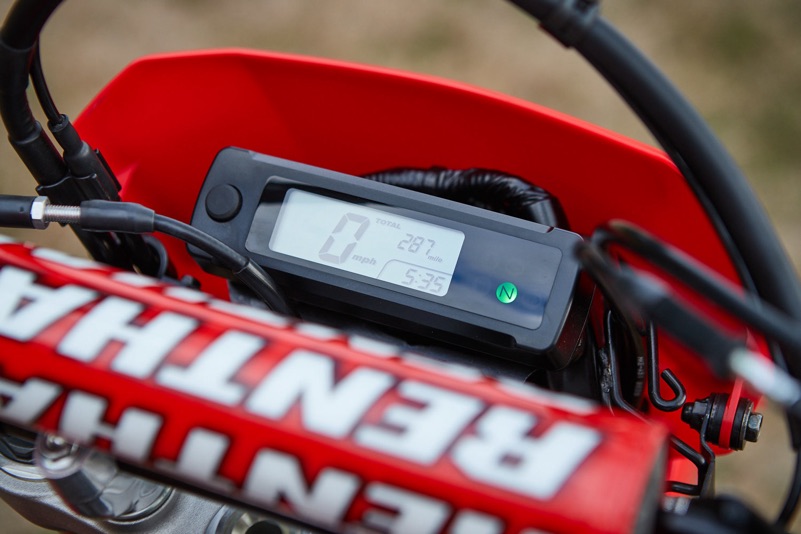
The CRF 450L comes with a factory one year warranty and Honda also offers up to an additional five years (which seems crazy that Honda will cover any issues you have with your basically off road bike for up to 6 years). And to top it all off it has an MSRP of $10,300 which is $900 less than the KTM and Husqvarna. Another thing that some keyboard warriors have been hounding on is the maintenance schedule of oil changes, which is every 600 miles and valve checks every 1,600 miles. Some people are saying that’s too frequent, but in my opinion that’s a lot of riding without having to worry about anything (this is also much less frequent than the competition). Honda put on a hell of an event at a great location with great people, everyone at the event worked their butts off and I feel super lucky to be one of the first people to ride the next level in the dual sport world. To sum it all up I think that Honda did all they could do, “legally” to make the best street legal dirt bike that is still a pleasure to ride on the street. Is it still corked up? Yes. Does it have more potential? Yes. But it’s going to be up to the aftermarket to take this bike from being a home run to a grand slam. If it were me personally I think there are only two things I’d do to personalize this bike for myself. I’d get an exhaust (a quiet one) to open up the engine to its full potential as well as get the mapping richened up (when this service is available). This bike falls under the category of (for the most part) don’t mess with a good thing. Honda engineers, as well as riders like Johnny Campbell have put a lot of time into making the CRF450L this good. Honda may be a little late to the dual sport party, but after seeing all the effort put into this project they clearly mean business and are here to stay. If you have any more questions about the 2019 CRF450L feel free to reach out to me at Michael@keeferinctesting.com.
